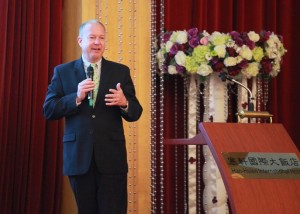 The world is rapidly changing. The opportunities and needs are changing. Governments, Businesses and Nonprofits/NGOs have been functioning fairly independently of each other, doing what they have been tasked to do. As society becomes more complex, the challenges are more complex, resulting in the need of new ways of getting things done. Plus, both governments and nonprofits/NGOs are often facing larger caseloads with fewer resources. Businesses are moving towards corporate social responsibility and sustainability models, where value is shared between the financial bottom line, society and the environment. There are partnerships, cross sector collaborations and other forms of the three pillars working together. Many of these partnerships have become very effective in accomplishing the joint goals of the participants. Yet the long term funding viability continues to be a challenge. Social enterprises are not only a way to help generate revenue, but often a better service delivery system.
The world is rapidly changing. The opportunities and needs are changing. Governments, Businesses and Nonprofits/NGOs have been functioning fairly independently of each other, doing what they have been tasked to do. As society becomes more complex, the challenges are more complex, resulting in the need of new ways of getting things done. Plus, both governments and nonprofits/NGOs are often facing larger caseloads with fewer resources. Businesses are moving towards corporate social responsibility and sustainability models, where value is shared between the financial bottom line, society and the environment. There are partnerships, cross sector collaborations and other forms of the three pillars working together. Many of these partnerships have become very effective in accomplishing the joint goals of the participants. Yet the long term funding viability continues to be a challenge. Social enterprises are not only a way to help generate revenue, but often a better service delivery system.
I was honored to be asked to present the opening keynote address at the 2015 Social Enterprise Conference held in Kaohsiung City, Taiwan. The two day convening brought together representatives of social enterprises, impact investing, corporate foundations, incubator agencies, nonprofit/NGOs, students and governments with international speakers from Hong Kong, Singapore, Tokyo and Bangkok. The goal of the conference was to share insights on the various aspects and types of social enterprises, showcase examples of successful social enterprises that are growing and replicable, and when applicable, promote the transformation of NGOs into social enterprises.
 Quoting Wikipedia, “a social enterprise is an organization that applies commercial strategies to maximize improvements in human and environmental well-being – this may include maximizing social impact rather than profits for external shareholders. Social enterprises can be structured as a for-profit or non-profit.” It is the blending of for-profit and non-profit strategies that are proving to not only be an effective way for the organization to achieve its goals and meet its mission, but a sustainable model as well. It really is about breaking down the traditional boundaries between the nonprofit and private sectors and creating hybrid or dual purpose entities. Reflecting this new structure, in some countries, there is a “B Corp,” or Benefit Corporation, legal status. There are variations in models across the social enterprise spectrum, the space between the traditional non-profit and the tradition for-profit enterprises. The sweet spot is in the middle where the best of both are working in an integrated approach resulting in social and financial value creation.
Quoting Wikipedia, “a social enterprise is an organization that applies commercial strategies to maximize improvements in human and environmental well-being – this may include maximizing social impact rather than profits for external shareholders. Social enterprises can be structured as a for-profit or non-profit.” It is the blending of for-profit and non-profit strategies that are proving to not only be an effective way for the organization to achieve its goals and meet its mission, but a sustainable model as well. It really is about breaking down the traditional boundaries between the nonprofit and private sectors and creating hybrid or dual purpose entities. Reflecting this new structure, in some countries, there is a “B Corp,” or Benefit Corporation, legal status. There are variations in models across the social enterprise spectrum, the space between the traditional non-profit and the tradition for-profit enterprises. The sweet spot is in the middle where the best of both are working in an integrated approach resulting in social and financial value creation.
As a fun way to demonstrate various types of social enterprises, I presented Eating with Purpose… around the world. Being a foodie, I have noted the rise of restaurants as social enterprises. Celebrity chef Jamie Oliver has a for-profit restaurant that is one of the finest in London, England. It is located in an underserved community and provides jobs, but more importantly, skill development for neighborhood youth. After a year, the youth go off to work in other restaurants with one of the finest on their CV. Plus, Jamie gives the profits to his foundation. In Bangkok, Thailand, there is Cabbages & Condoms, a fun, yes, family restaurant that promotes understanding and acceptance of family planning while generating a revenue stream for the Population and Community Development Association. In Melbourne, Australia, many of Charcoal Lane’s past and current staff are Aboriginal and have experienced family conflict, mental health, drug and alcohol issues in addition to having lower levels of education. This too is a training ground for the restaurant and hospitality industries. I’ve dined at all three and can confirm that the food is delicious.
 Social enterprise start-ups are being funded through impact investing and venture philanthropy. There are incubators and other programs that help social entrepreneurs get started or convert existing businesses or organizations. The methods of income generation range from fee-for-service, products, services, dues and unrelated business activities through restaurants, retail, manufacturing, banking, landscaping, ecotourism and just about anything that can be imagined. Many have become world renowned with recognizable names such as Grameen, Goodwill, Homeboy and Tom’s. The possibilities are endless and the need is great. Social enterprises are quickly becoming one of the most impactful models of social service delivery in the 21st century.
Social enterprise start-ups are being funded through impact investing and venture philanthropy. There are incubators and other programs that help social entrepreneurs get started or convert existing businesses or organizations. The methods of income generation range from fee-for-service, products, services, dues and unrelated business activities through restaurants, retail, manufacturing, banking, landscaping, ecotourism and just about anything that can be imagined. Many have become world renowned with recognizable names such as Grameen, Goodwill, Homeboy and Tom’s. The possibilities are endless and the need is great. Social enterprises are quickly becoming one of the most impactful models of social service delivery in the 21st century.
